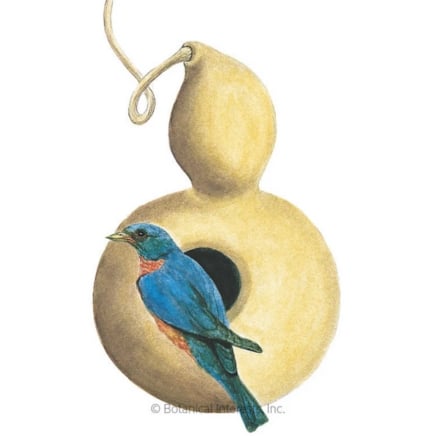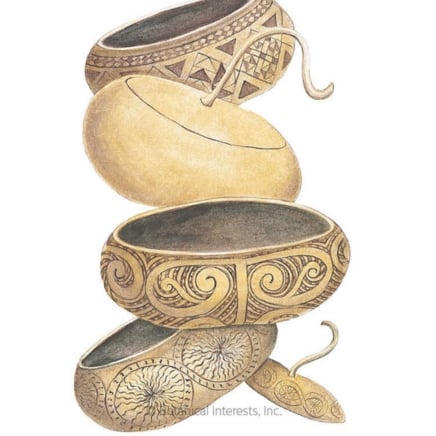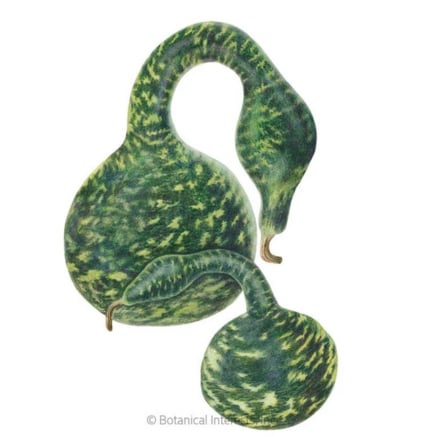PROTECT YOUR DNA WITH QUANTUM TECHNOLOGY
Orgo-Life the new way to the future Advertising by AdpathwayGourds grow similarly to vining squash. They have male and female flowers, large green leaves, and twining stems. The plants will clamber up trellises, stakes, and upright supports to fill your garden with lush growth.
Most gourds are unusual, as they aren’t for edible purposes. Gourds tend to be inedible and bitter, making them ideal for crafts and projects rather than Thanksgiving dinner. The more interesting they look, the more likely they are to be popular among gardeners and growers.
These 11 unusual gourds are some of the most interesting-looking varieties. Plant their seeds in the summer garden for a fall harvest. You’ll have plenty of gourds to turn into birdhouses, ladles, and decor!
Birdhouse

Birdhouse Hard-Shelled Gourd Seeds
Corsican

Corsican Gourd Hard-Shelled Seeds
Speckled Swan

Speckled Swan Hard-shelled Gourd Seeds
‘Autumn Wings’
 Their quirky knobs and side wings steal the autumn show.
Their quirky knobs and side wings steal the autumn show.‘Autumn Wings’ is a collection of colorful gourds with knobs, warts, and wings. The fruits resemble long spoons, except they have wings on their sides. No two will sprout alike!
The vines need anywhere from 95 to 100 days after planting to form full-size fruits. Plant them as soon as the weather permits in late spring and early summer. The earlier you plant them, the more you’ll have to harvest in the fall.
This gourd is a variety of the Cucurbita pepo species. It’ll readily cross-pollinate with other varieties in the same species, like squashes and zucchinis. If you plan on saving seeds from this vine, plant it far away from any other C. pepo plants in your garden.
‘Birdhouse’
 Harvest late, and the shells become nature’s own lumber.
Harvest late, and the shells become nature’s own lumber.You don’t need wood to make a birdhouse; all you need is a ‘Birdhouse’ gourd vine! This unusual fall gourd variety grows round, two-chamber fruits that are tough and durable. You can treat them like wood. Sand, paint, or drill into them to make whatever crafts you can dream of.
For the most durable skin, leave the gourds on the vine until the plant dies back in late autumn. The long process allows them to harden and cure, so they’ll tolerate drilling and sawing.
When harvesting, cut off a few inches above the gourd’s stem. Leave the stem intact so you can hold the gourd while you treat it.
‘Corsican’
 Perfectly shaped fruits make crafting feel extra satisfying.
Perfectly shaped fruits make crafting feel extra satisfying.Some gourds have many uses, like the ‘Corsican’ variety. This plant grows oval, thick fruits with hard, brown shells. Their even shape lends well to a variety of different crafts.
Cut their tops and scoop the insides out to make a jewelry box. Or, throw the tops away and make bowls! Use a sharp knife to carve designs into the shell, or paint the outside with your favorite colors.
Although these vines reach epic proportions, you can plant gourd seeds close together if you’re training them up a vertical support. Keep in mind that these vines reach 30 feet long! They’re perfect for tall arbors and obelisks.
‘Daisy’
 Grown for fall flair, they’re shaped like garden blossoms.
Grown for fall flair, they’re shaped like garden blossoms.Decorative gourds are essential if you plan on throwing fall gatherings. Homegrown ones last many months without losing their color, making them perfect for mantles, countertops, and centerpieces. ‘Daisy’ is one of the best types!
‘Daisy’ plants sprout flower-shaped fruits with petal-like patterns. The patterns resemble daisies, hence their name! Some may have yellow or white petal marks, while others will have green or orange patterns.
‘Daisy’ is a variety of C. pepo, meaning it’ll cross-pollinate with your squashes and pumpkins. Consider a different variety if you plan on saving seeds from your cucurbits.
‘Dinosaur’
 Bumpy green skin gives them that ancient, wild garden look.
Bumpy green skin gives them that ancient, wild garden look.Dinosaur lovers should grow ‘Dinosaur’ gourds! These fruits sprout reptilian-like green skin with ridged bumps. Their unusual appearance makes them stand out in the summer garden. They’re unlike any other gourd you’ve seen.
Unlike Cucurbita gourds, Lagenaria species, like ‘Dinosaur,’ sprout white flowers that open at night. They attract hummingbirds, making them perfect for pollinator gardens with other flowering plants. Or, plant ‘Dinosaur’ with other night-blooming white-flowering species to create a moon garden.
This variety does not cross-pollinate with other cucurbits, making it perfect for growing alongside squashes and pumpkins if you want to save their seeds.
‘Dipper’
 Each one turns from garden gourd to handmade kitchenware.
Each one turns from garden gourd to handmade kitchenware.‘Dipper’ gourds sprout into functional shapes that you can use in your kitchen! Let them dry, cut a hole in their bottoms, and use them as ladles or dippers.
To help your ‘Dipper’ ladles last as long as possible, hand wash them after every use. Avoid putting them in your dishwasher. The hot drying temperatures in dishwashers can cause the ladles to buckle and break.
Go the extra mile by decorating your ladles! Carve them, make stencils in them, or paint them with a food-safe paint.
‘Hoargarth’
 Orange-bottomed gourds pop against deep green leaves all season.
Orange-bottomed gourds pop against deep green leaves all season.‘Hoargarth’ is a new variety that’s perfect for small spaces. It’s a semi-bush type of gourd, meaning it grows bushy plants that may form short vines at the end of the growing season. Off the vines sprout round, warty fruits with green tops and orange bottoms.
You may plant this type in a large container and let it drape over the sides. Keep the soil moist, not soggy, and stake long vines with a trellis or similar support system.
A prolific producer, ‘Hoargarth’ is more productive than most other varieties. Be careful—if you grow more than one plant, you’ll have enough unusual gourds to give to your entire neighborhood!
‘Luffa’
 These green tubes dry into tough little scrubber rings.
These green tubes dry into tough little scrubber rings.Don’t buy plastic sponges from the store—grow your own instead! ‘Luffa’ gourds sprout into long, cucumber-like shapes. Their flesh is thick and fibrous. As they dry, the fleshy strings grow hard inside and make perfect sponge material.
Harvest ‘Luffa’ fruits after the vines die back in late fall and early winter. Let them dry, then slice them into rounds to use for cleaning, spongeing, or scrubbing. Remove the inner seeds before using them, and plant them next year.
Unlike the other species, Luffa aegyptiaca requires four or more months to form mature fruits. Start seeds in paper pots indoors in regions with short growing seasons. Use paper pots so you can transplant them directly into the garden without disturbing their roots.
‘Martinhouse’
 Craft lovers love their size, and gardeners love their shape.
Craft lovers love their size, and gardeners love their shape.Unlike the other unusual types, ‘Martinhouse’ gourds are relatively even-shaped! They form pear shapes that reach 10 inches wide and 15 inches tall. They’re massive. Their large, even shape makes them ideal for a range of crafts.
Make ‘Martinhouse’ fruits into birdhouses, clogs, decorations, or bowls. The possibilities are endless. They’re also decorative in the garden as they grow on the vines. Train the plants up an archway to create a living spectacle, as the lush leaves provide shade and the gourds hang down from the arch.
‘Speckled Swan’
 Curved neck gourds that steal attention every autumn season.
Curved neck gourds that steal attention every autumn season.Some plant names are so descriptive that you can envision the plants purely by their names. ‘Speckled Swan’ is one of them! The gourds grow into curved neck shapes that resemble swans. They have dark green skins with light green speckles.
Highly unusual, ‘Speckled Swan’ fruits are knockouts in the yard. They look great as decorations in autumn and winter, and they last a long time when you cure them.
To cure them, place them in a warm and dry location. Turn them daily to ensure they dry evenly. They should be cured fully after a few weeks. Shake them to see if you can hear the seeds rattle inside; if you can hear them shaking, then the gourds are ready for craft making.
‘Turk’s Turban’
 Two-chambered gourds have colors that brighten any autumn table.
Two-chambered gourds have colors that brighten any autumn table.‘Turk’s Turban’ is a type of pumpkin! Unlike the other gourds, it’s a variety of Cucurbita maxima, the pumpkin and winter squash species. It sprouts gourds that have two round chambers. They form shapes that resemble turbans, with a round bottom section and a smaller top section.
The two sections have a range of many different colors and textures. Find ones with white, green, and orange hues.
These gourds won’t keep well like the other varieties. They’re also edible! Instead of curing and keeping them, use them in pumpkin pie, roasted recipes, or casseroles.


 1 week ago
13
1 week ago
13





















 English (US) ·
English (US) ·  French (CA) ·
French (CA) ·